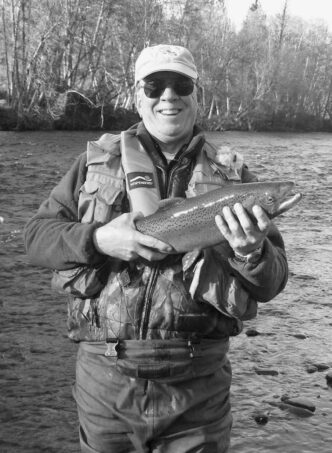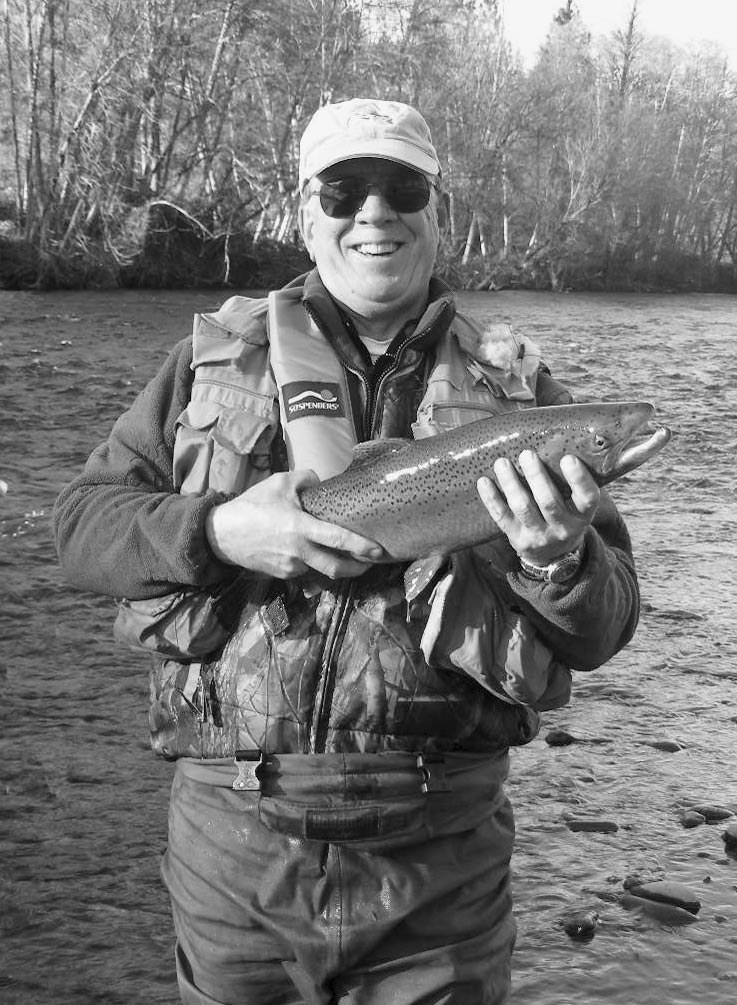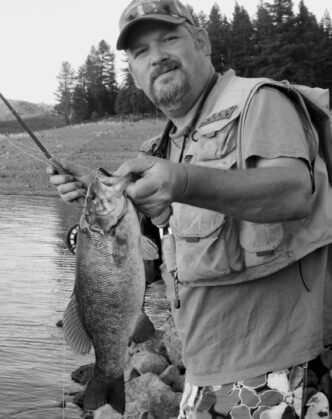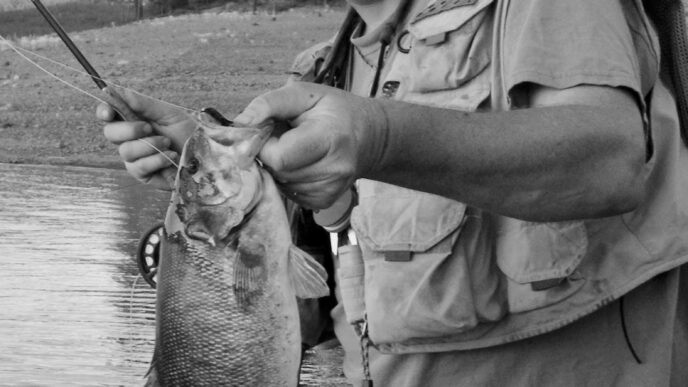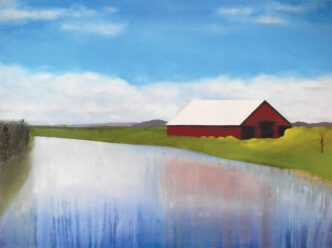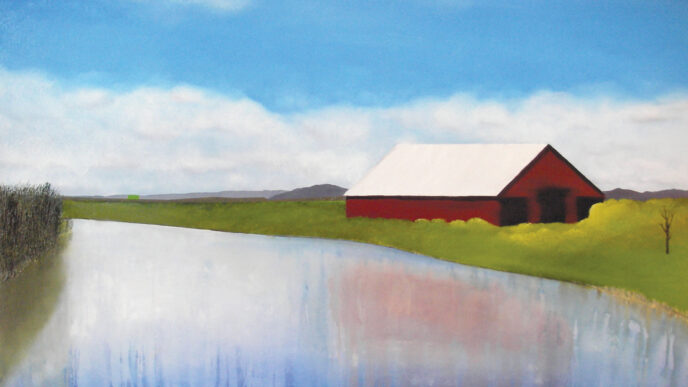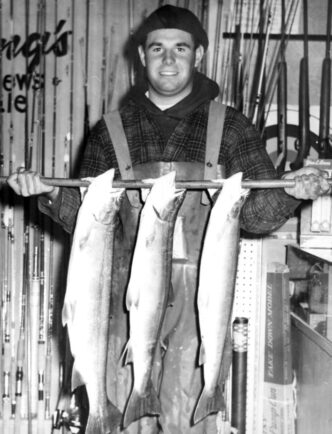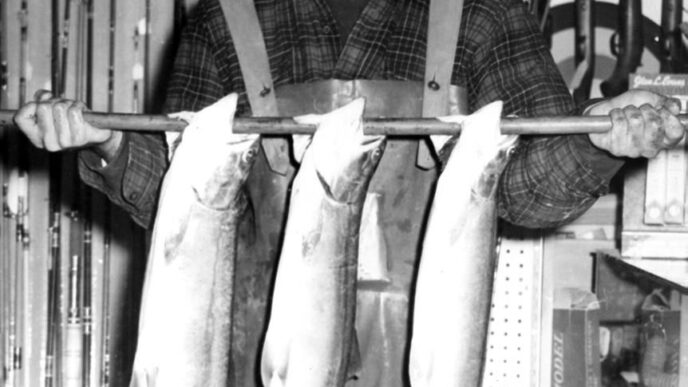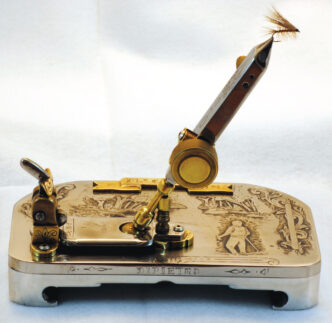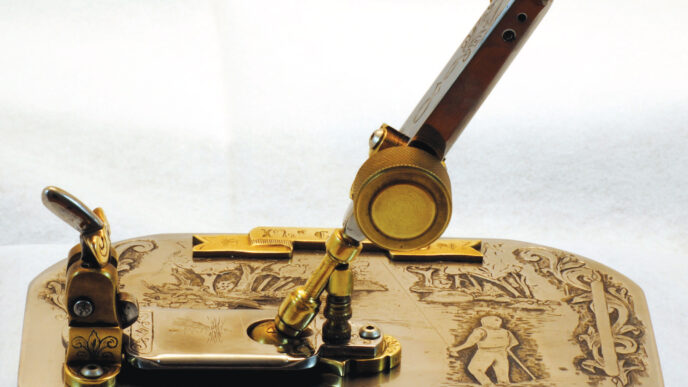Victor Johnson has fished all over California, the United States, and the world. You may have run into him on one of his favorite streams, but most people know him because of the contributions he has made to the literature devoted to the history of fly fishing: first, Fiberglass Fly Rods, with his father, Victor Johnson (1996), and then, on his own, with America’s Fly Lines (2003), Fenwick (2005), and America’s Fishing Waders (2008), all now available from EP Press ([707] 644-4788, www.engineeringpathways.com/press.htm). In his review of America’s Fishing Waders in this magazine (“The Paper Hatch,” California Fly Fisher, January/February 2009), D. C. Ounty wrote that it, like all of Johnson’s books, is “a must-read for anyone interested in the technological developments to angling gear that got us . . . where we are now.” The long and varied history of fly fishing is one of its many attractions, and Victor Johnson has made fascinating contributions to our knowledge and understanding of that history.
Bud: You’re from Arkansas, I’ve read. What brought you to California?
Vic: I graduated in June 1967 with a degree in civil engineering from the University of Arkansas. This period was the height of the Vietnam War (the Tet Offensive was in January 1968). Like most new graduate engineers, I expected to go to Vietnam. As it turned out, the Humble Oil and Refining Company (later renamed Exxon) was building a refinery in Benicia, California, and supporting facilities for it throughout the state. The military needed petroleum products for the war, and draft boards generally exempted engineers working for oil companies. Exxon hired me. My wife and I went from living in a 10-foot by 50-foot house trailer in Fayetteville, Arkansas, to living in a spacious apartment in Hayward, California, in a four-day period after graduation. I was a very lucky young graduate, because several of my classmates made the ultimate sacrifice for our country.
My first assignment was as a construction and maintenance engineer for Northern California. This allowed me to see much of this part of the state in a relatively short period of time. Since I was on the road so much, I would spend my evenings finding good fishing and camping spots. Then I would then take my wife, Sarah, and two young daughters (Elizabeth and Kristine) to these spots on our vacations. We still go to many of those same locations 40-plus years later.
Bud: A friend of mine recently moved to Arkansas, and he did so because he claims it’s Heaven for fly fishers. Did you get interested in fly fishing there, or after you’d moved to the Golden State?
Vic: My family moved to Arkansas my senior year in high school. Prior to that time, I had lived in western Michigan. I had done some fly fishing in Michigan, but predominately had done my fishing with spinning equipment. I gradually moved to fly fishing while in Arkansas. The White River in Northern Arkansas is one of the best brown trout fisheries in the United States and maybe the world. I was able to fish it numerous times each year I lived in Arkansas and still try to go back to it at least once a year. I got married midway through college, and my new wife also began to fish actively. For college students on a tight budget, fishing was a fun and inexpensive form of recreation.
Bud: As anglers, we’ve all had mentors along the way. Who helped you out?
Vic: My dad loved to fish and always helped me. He was a chemist, and my mother was a school teacher. They always felt cooped up, working inside all day, so virtually all of our family’s free time was involved in hunting, fishing and camping. My brother Bill and I started going fishing with our father from the time we were big enough to cast a rod. We fished for all types of fish — bluegills, bass, perch, pickerel, pike, and trout. We even did ice fishing in the winter!
I did not know it at the time, but it was my Dad’s Shakespeare Wonderod fly rod that many years later led to our writing books. Shakespeare had invented its Wonderod in the mid-1940s, and its manufacturing plant was in Michigan. Everyone we knew wanted one of their new fiberglass rods. In the 1950s, my mother got my father a Wonderod fly rod and Shakespeare automatic fly reel for a birthday or Christmas present. Soon, all family members were experimenting with it. That was my first introduction to fly fishing.
Bud: First in Fiberglass Fly Rods with your dad and then in America’s Fly Lines, Fenwick, and America’s Fishing Waders, you’ve done an amazing amount of highly detailed research into the history of very specialized aspects of American fly-fishing history. Many people have some love of and interest in the history of the sport, but tend to be content with accounts of Dame Juliana Berners and Theodore Gordon. Where did this interest in — or passion for — history come from, and what sustains it?
Vic: I would like to say my father and I had a formula for our books figured out from “Day One,” but we did not. We both enjoyed reading history-oriented books, and in the early 1990s, my father and I talked about his first Shakespeare fiberglass fly rod and its construction. It was interesting that he (being a chemist) and I (being an engineer) did not know much about fiberglass rods — even though we had fished with them since the 1950s. The library also did not have much information on the subject. We simply decided that researching and writing a book about the history of fiberglass fly rods would be a good father-son project.
Our logic, or lack of logic, was that a research-intensive topic common to all fly fishers that has never seriously been written about would not have any competition. It would make our book both the worst book ever written on the topic and the best book ever written on the topic — because it would be the only one written on the topic. In this way, we could make a unique contribution to the sport that had given us so much pleasure.
We had not been part of the history of what we were writing about and were not experienced authors. It was obvious early on that we needed someone to “vet” our research to make sure it was accurate. Who to ask was the question. I built up my courage and called Leon Chandler at Cortland and asked him to help us. Leon was a giant in our sport, and I had no idea how he would react. Amazingly, he said he would be glad to assist and also agreed to write a foreword to the book. Leon also helped us in America’s Fly Lines, then Don Green helped with Fenwick, and Ron Foster helped with America’s Fishing Waders. I will be forever grateful to these giants of our sport for the help they gave in contributing to our books.
Bud: In the previous “California Confluences” column, I interviewed Justin Coupe, and he talked about the process of getting access to some of the principals in the story he had to tell, their memorabilia, and their memories. You must have faced similar challenges doing the kind of research you’ve done. It demonstrates competence in a wide variety of fields. What were some of the obstacles you had to overcome — for example, in putting together the many biographies that your works contain?
Vic: The first challenge was that the pioneers of modern fly fishing were getting older (and so were we). It was evident that if their contributions were going to be recorded, it needed to be done sooner, rather than later. People have a natural caution about working with other people they do not know. Our strategy to overcome this obstacle was to go visit the people we wanted to interview. My dad was retired and had the time to visit. Since my work took me routinely all over the United States, I also had time to visit.
It turned out that the group we wanted to interview all generally knew each other — the fly-fishing community is really a small world. After a dozen or so personal visits, the people we had interviewed started calling ahead to the other pioneers and giving us introductions. That allowed us to go faster and also not to have to visit in person each individual we wanted to interview. It also turned out that many of them had always wanted to record their efforts, but had never had a vehicle to do so. We became that vehicle, and Fiberglass Fly Rods was really their composite story that we recorded. This composite-story format has been the same for the subsequent books. On the whole, this approach worked.
We were able to complete the research phase in about two years. As we got into America’s Fly Lines, some of the key people began to die. One of those key people was my father. I still greatly miss him.
The second challenge was getting the first book published. We have all heard about first-time authors having their first book rejected by numerous publishers before finally succeeding. Well, that is true. I can’t tell you how disappointing it was to come home from work and find that yet another publisher had rejected our book. Finally, we found a couple of publishers who wanted to do the book and selected Centennial Publications in Colorado. I will always have a warm spot in my heart for them.
Once Fiberglass Fly Rods was published, the subsequent books became much easier to research and publish. I would send the person I wanted to interview a copy of my earlier book(s) to show them what I was trying to do. The vast majority would cooperate. If a key person would not cooperate or had died, the other people I had previously interviewed would normally have suggestions of other ways to get the required information.
Bud: After your first book you decided to self-publish the next three. How has that worked out?
Vic: I have been very happy with that decision. As I said earlier, I have a warm spot in my heart for Centennial Publications, which published our first book. Overall, they did a fine job, but it was a learning experience for me. I found out that publishers have the right to eliminate some of an author’s work as they “tighten up” the original text to meet a desired number of pages for the book. A few pieces of historical research we had prepared did not make it into Fiberglass Fly Rods.
I could have continued on the same course with my subsequent books, but it seemed that with modern computers and the Internet, I might be able to self-publish. In that way, I could make sure that all my research made it into the final book. I was able to assemble a team of independent editors and graphic specialists into a virtual publishing firm (EP Press). Once my second book, America’s Fly Lines, was ready for printing, I found a good printer and decided to self-publish it.
I will freely admit it is a sobering moment when a truck comes up and deposits several thousand books on your driveway. There is a moment of fear: “What will I do if these do not sell?” Fortunately, there are a number of high-quality book distributors in our sport that will carry your books.
Bud: Both you and your dad have had backgrounds in the hard and/or applied sciences. One of the striking things about these books is the level of technical knowledge that they provide. How did your training as a civil engineer help you in researching and writing these books?
Vic: It may not make a lot of sense to literary professionals, but I differentiate between “authors” and “writers.” In my mind, “authors” are “authoritative” on a topic, and through extensive research virtually anyone can be an author. Civil engineers like me routinely research problem issues in depth (often as part of a research team) so as to be able to find a solution to them. Normally, the solution ends up in a written report with key inputs from a number of people, including technical editors, graphics specialists, and so on. In that sense, my normal profession has helped me become an author.
Good writers, in my mind, are very different. They have God-given skills to use language to create emotion, drama, and other things. I do not have those writing skills.
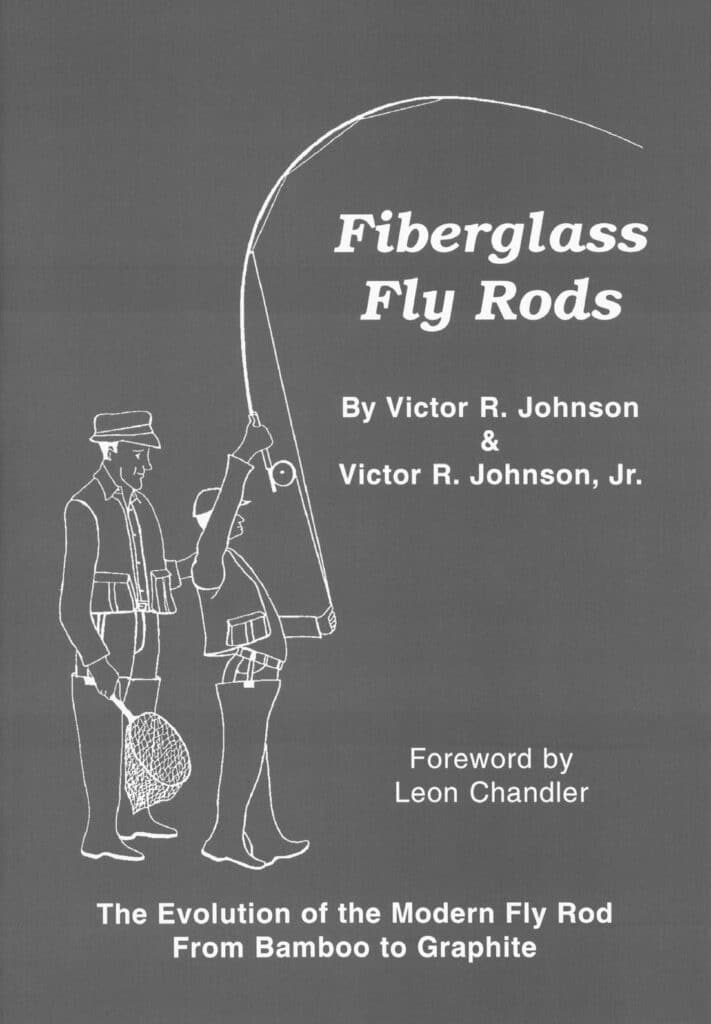
Bud: Part of the story in America’s Fly Lines involves the role that the Sunset Line and Twine Company and San Franciscan Myron Gregory played in the evolution of fly lines. California has a reputation for innovation, but fly-line technology is not usually mentioned in that connection. What role did Californians play in the development of the fly line as we know it today?
Vic: California has had an important role in the history of the modern fly line — particularly Northern California. This is primarily due to two factors. First, we have the Golden Gate Angling and Casting Club (GGACC), which is arguably the best tournament casting facility in the United States and possibly the world. An additional plus is that it is open to the public and it is free. It was built in 1938 by the Work Projects Administration of the federal government.
In the 1940s and 1950s, the GGACC was a hotbed of fly-line designers, and several of its members became world champion fly casters. One of its members, Myron Gregory, led the development of the flyline classification that everyone uses today. This standard, which was adopted in 1958, is based on line weight (not line diameter, which had previously been the standard). The history of this watershed development in modern fly lines was truly fascinating to research and chronicle.
The second key California factor was that Sunset Line and Twine Company was also based in Northern California. Sunset was a major national fly-line manufacturing company dating back to 1932. It provided the initial fly lines that many of the GGACC members were involved with improving in the 1940s and 1950s. Art Agnew, the controlling stockholder of Sunset, was also chairman of the American Fishing Tackle Manufacturers (AFT-MA) Special Line Committee when the new weight standard was proposed. His skill in working with the nation’s fly-line manufacturers was instrumental in getting Myron Gregory’s line-weight standard adopted. Additionally, Sunset worked with the GGACC in the development of the first shootinghead fly lines. Finally, the company also developed Amnesia monofilament, which is popular even today.
In fairness, other states can also claim significant contributions to the modern fly line. Michigan (Scientific Anglers), New York (Cortland), and others have companies that did much to develop the modern fly line.
Bud: As an engineer, you work in the fields of environmental engineering and hazardous-waste management. Both are unfortunately but necessarily topics of interest to every California fly fisher. Waters in California, around the country, and worldwide face and will continue to face numerous challenges. How do you assess the current state of environmental protections for California waters, and what challenges do you see in the future?
Vic: I have been fortunate in that my profession took me at first all over the United States and later evolved into an international practice. This travel (and fishing along the way) has given me some degree of understanding of the state of the lakes, rivers, and streams on our planet. It is always dangerous to generalize, but on whole, the water quality in the United States (and California) and Western Europe has improved since I started practicing engineering in 1967. Conversely, the water resources in many Second World countries and most Third World countries have deteriorated. Given that the world’s population is ever increasing, protection of the planet’s water resources will become more and more important each year.
The argument you get from professionals in Second World and Third World countries is that they are now building up their economies and want to be able to continue to pollute in order to make lowcost goods — just like the United States did when we were building up our economy. This worldview obviously does not take into account the fact that all the world’s environment is interrelated, and one person’s detrimental actions affects fellow neighbors. I am afraid that the First World countries will actually have to subsidize and/or incentivize the protection of water resources in some Second World countries and many Third World countries in order to protect the common oceans.
Although the quality of California’s water has generally been improving, we have yet to address adequately the quantity issue. There is simply not enough water to give each sector that depends on water (people in general, agriculture, fish, and so on) all the water it needs. Even with aggressive water conservation, we will need to build new dams and canals to meet California’s water needs going forward.
It is also clear that our interrelated world environment will result in more foreign pests such as the mud snail entering California’s lakes, streams, and rivers. Again, we will have to respond to each new threat with vigor.
In spite of these considerable future challenges to California’s and the world’s water resources, I am confident that we can meet them and continue to enjoy the sport of fly fishing. We just need to stay vigilant and we will be all right.
Bud: You’ve been fortunate enough to be able to fish all over the world, thanks to your professional travels. What are your favorite places to fish?
Vic: My favorite river is the Trinity River in Northern California. I especially like the stretch of the river at Lewiston. My wife, family, and friends have fished there countless times. We also like saltwater fly fishing at Punta Colorada in Mexico and go there at least once a year. Finally, any water that my two grandsons (Bryson, age 4, and West, age 2) and I fish is also great. (They like to fish with worms, which is also fine.)
Bud: Here we are already at the traditional Silly Tree Question. If you were a tree, what kind of a tree would you be?
Vic: There was a huge old oak tree on the property of my wife’s parents in Arkansas. It had a rope swing on it, and it also provided shade for family picnics and other gatherings. I have often thought it must be a happy tree for all the pleasure it has given children and adults (and then their children and grandchildren) over its lifetime. That is my favorite kind of tree.



